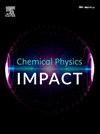NiS-ZnS quantum dots as visible-light photocatalysts for enhanced dye degradation in sustainable wastewater treatment
IF 4.3
Q2 CHEMISTRY, PHYSICAL
引用次数: 0
Abstract
Nickel Sulfide–Zinc Sulfide Quantum Dots (NiS-ZnS QDs) have gained attention as efficient photocatalysts for breaking down organic dyes due to their adjustable optoelectronic characteristics and improved photocatalytic efficiency. In the present work, NiS, ZnS, and NiS-ZnS QDs were prepared using a chemical precipitation approach and thoroughly analysed through characterization techniques. The incorporation of Ni into the ZnS lattice was found to significantly modulate the band gap, facilitating improved visible light absorption. The photocatalytic performance of the synthesized NiS-ZnS QDs was evaluated through the degradation of Methylene Blue (MB) and Rose Bengal (RB) under visible-light irradiation. The results demonstrated a substantial enhancement in dye degradation efficiency compared to ZnS QDs and NiS, attributed to the suppression of electron-hole recombination, increased generation of reactive oxygen species (ROS), and improved charge carrier separation. Remarkably, the NiS-ZnS QDs achieved degradation efficiencies of 96.91 % for MB and 97.12 % for RB under visible light exposure, showcasing their superior photocatalytic activity. These findings highlight the potential of NiS-ZnS QDs as a highly efficient and economically viable photocatalyst for sustainable wastewater treatment applications. Furthermore, the efficient degradation of mixed dye solutions highlights the practical applicability of the photocatalyst, underscoring its potential for real-world wastewater treatment applications. Tuning the optical and electronic properties of these quantum dots via nickel doping offers promising opportunities for designing advanced photocatalytic materials aimed at environmental cleanup.

NiS-ZnS量子点作为可见光催化剂在废水可持续处理中增强染料降解
硫化镍-硫化锌量子点(NiS-ZnS QDs)由于其可调节的光电特性和提高的光催化效率而成为分解有机染料的高效光催化剂。本文采用化学沉淀法制备了NiS、ZnS和NiS-ZnS量子点,并通过表征技术对其进行了深入分析。在ZnS晶格中掺入Ni可以显著调节带隙,促进可见光吸收。通过在可见光照射下对亚甲基蓝(MB)和孟加拉玫瑰(RB)的降解,评价了合成的NiS-ZnS量子点的光催化性能。结果表明,与ZnS量子点和NiS相比,染料降解效率显著提高,这是由于抑制了电子-空穴复合,增加了活性氧(ROS)的产生,并改善了载流子分离。值得注意的是,NiS-ZnS量子点在可见光下对MB和RB的降解效率分别达到96.91%和97.12%,显示出优异的光催化活性。这些发现突出了NiS-ZnS量子点作为一种高效且经济可行的光催化剂的潜力,可用于可持续的废水处理。此外,混合染料溶液的有效降解突出了光催化剂的实用性,强调了其在实际废水处理应用中的潜力。通过镍掺杂调整这些量子点的光学和电子特性,为设计旨在环境净化的先进光催化材料提供了有希望的机会。
本文章由计算机程序翻译,如有差异,请以英文原文为准。
求助全文
约1分钟内获得全文
求助全文
来源期刊

Chemical Physics Impact
Materials Science-Materials Science (miscellaneous)
CiteScore
2.60
自引率
0.00%
发文量
65
审稿时长
46 days
 求助内容:
求助内容: 应助结果提醒方式:
应助结果提醒方式:


